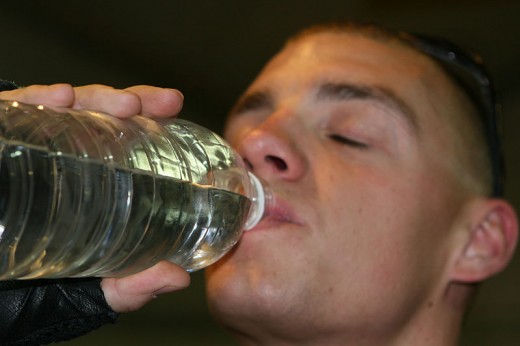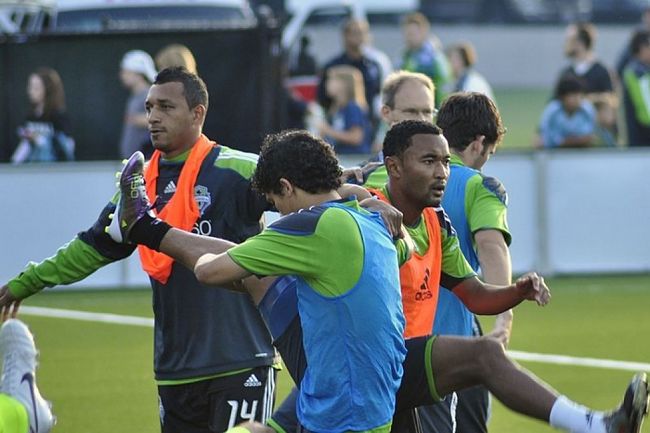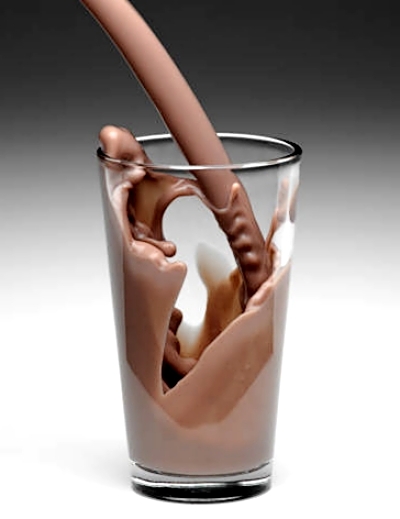Recover Faster from Workouts, Training and Exercise Sessions
Thorough and effective recovery after training sessions, workouts and competitions, allows active people to return to their normal state and achieve physiological and psychological well-being) as quickly as possible.
This means that your performance in your next training session or competition will not be hampered by muscle soreness, inadequate re-hydration and feelings or tiredness, fatigue and lack of enthusiasm.
Just like a proper and effective warm-up, there is a proper and effective way to recover faster from training sessions, gym workouts, runs, swims and various exercise sessions.
This article shows you how to recover quickly and effectively.



Read the warning signs and accept the flags that get waved when you are feeling tired, have sore muscles, your performance falls off or you start to feel flat. Vary your program depending on how you feel and get to know our 'magic pace'. Niggling injuries can build up, and while small may add up to a major impairment. Overdoing it after ignoring the warning signs increases the risk of injury requiring major time-out.
So you need to manage your recovery well. While you need to be disciplined and abide by the motto: "There is no gain without pain", you should not involved in double-talk. "Why do I feel tired now after such a light session." "I'll run out that strain I feel - I have to complete my training schedule, I can't stop now." The need for discipline and setting challenging schedules needs to be balanced by the need for adequate rest and recovery, and controlling the risk of injury and over-exertion.
Essential Elementsfor Effective RecoveryThere are a number of ways to enhance recovery including:
- Cross-training
- Light exercises
- Mental relaxation techniques
- Compression garments
- Icing and Hydrotherapy
- Massage
- Stretching
- Warm-down
- Restoring ion balance
- Re-hydration
- Nutrition
- Sleep and rest
Why Adequate Recovery is Essential
In gym work, muscles grow and become stronger when they are worked hard and this can cause strains and tiny tears in the muscle fibers. Recovery is required to repair these fibers and strengthen them so they can work harder next time. This may also involve developing or enhancing blood supply to the stressed area. This all takes time.
Similarly developing endurance and aerobic capacity means enhancing the ability to consume more oxygen and deliver it to the muscles. Most of the energy need for muscles to work depends on glycogen which is stored in the muscles themselves rather than the general metabolism. It takes time to rebuild these stores each time they are depleted.
Similarly muscles work best when they are properly hydrated and have the correct balance of sodium, potassium and other ions. This ideal balance of water and ions that gets disrupted during exercise, needs time to recover and to be restored. Also, don't forget the mental aspects of recovery that are just as important.
How Do You Know Whether You are Overdoing It?
Excessive soreness and abnormal fatigue are generally signs that you either increased your session length or intensity too quickly, which will make it harder for you to recover quickly and properly. In a sense there is an ideal work rate that stimulates improvement but can be coped with via recovery. If you overdo it, the recovery may be inadequate or incomplete, leading to a downhill spiral in your condition.
There is a training outcome called “Delayed Onset Muscle Soreness". Often muscle soreness is not worse immediately after a workout, but perhaps as much as 24-48 hours, and even longer after the workout. If you have sessions every day or every second day you need to be aware of this. Read the warning signs.
Steps and Tips for Proactive Recovery
Recovery processes include:
- replenishing the water and electrolytes lost in sweat
- replenishing the liver and muscle glycogen stores (carbohydrate used as fuel)
- helping the body make extra red blood cells and improve the circulation, repair and build new muscle protein, and develop other cellular components for repair and enhancement
- allowing enough time for the immune system and body repair processes to deal with the damage and body changes caused by exercise
For a proactive approach the person needs to adapt their recovery to the type and severity of the exercise and the potential damage and stimulus it may have caused. Key issues to consider are:
- How much fuel was burnt (lengthy and intensity of the exercise)
- How much muscle damage was caused (soreness)
- How much sweat was lost?
- What stimulus was generated for the body to build more muscle protein?
- How much food is needed to replenish the body’s energy stores.
Various Steps and Components for a Speedy Recovery
Refueling for Recovery
Glycogen stored in the muscles is the main fuel supply used by the body during moderate and high intensity workouts and exercise. The quickest way to replenish these stores is to consume carbohydrate which can be quickly digested, with components travelling through the blood stream to be converted to glycogen in the muscles. For very intense workouts a trained high-level athlete may need to consume between about 10 g of carbohydrate for each kg of body weight each day to keep the glycogen stores topped up (700 g per day for a 70kg athlete; 1.5 lb for a 150 lb athlete). Getting protein and other nutrients is also important, particularly for body builders and gym workouts.
Immediately after training people are encouraged to consume a carbohydrate and protein rich snack that provides about one gram of carbohydrate per kilogram of body weight within an hour of finishing. This is equivalent to 10g for a 70 kg athlete. This does not mean gorging on snack bars laden with sugar and fat, or fast-foods. The table below lists a series of ‘normal’ foods that can provide what is required. The list of ‘snacks’ shown provide at least 50g of carbohydrate. The remaining replenishment food can be eaten with usual meals, but carbohydrate if important.
Re-Hydration for Recovery
Most people who exercise, workout in the gym, train or compete in some way will finish with some extent of fluid deficit. Many athletes drink when exercising, but mostly it is not enough, especially with sweating. So people need methods of quickly restoring fluid levels and electrolyte balances. One way of determining how much fluid is lost is to weigh yourself, before and after. People should aim to consume all their fluid lost plus 25-50% during the 3-5 hours after exercise. It is important that the electrolytes are replaced as well, especially sodium and potassium. Water and professional sports drinks are good, but it is also worth considering flavoured milk, shakes and liquid meal supplements that allow you to replenish carbohydrate and protein at the same time.
Repair and Muscle Building Strategies during Recovery
Recent research has shown that consumption of essential amino acids and protein during the first hour after exercise helps to support muscle metabolism. Although there is no definitive research on the type, casein and whey supplements, and many of the protein rich foods listed below are suitable. Timing is important with 15-25g of high quality protein being needed in the first hour after exercise. See the list of foods below that contain about 10g of protein.
Supporting the Immune System During Recovery
The immune system is known to be suppressed during intensive training and this process can continue during recovery. While many athletes take vitamins and probiotics, recent research has shown that consuming adequate amounts of carbohydrate after exercise stimulates the body’s own immune system and gets it functioning again.
Real Food versus Supplements
Many people who train regularly can become reliant on sports food supplements believing that they are the easiest, most convenient and best recovery foods. However, ‘real foods’ (shown in the table below) are just as good if not better and can be just as convenient with a little fore thought and planning.
Cooling Down and Streching for Recovery
Cooling down simply means using the last part of the activity as a slowing down period after intense exercise. This helps to remove remove lactic acid from the muscles by keeping the blood circulating and may help to reduce muscles stiffness. Cooling down is just as important as warming up.
Stretching During Recovery
Gentle stretching after exercising is a must as it helps to relax strained muscles and to re-set muscle length. You show develop a post-exercise stretching routine.
Resting During Recovery
Many people forget to rest properly and to have a good night’s sleep. It is when your body is resting that the repair and muscle building takes place.
Active Recovery Exercises and Cross-Training
Easy, relaxing motion or cross-training is a good way to assist recovery as it keeps the blood circulating through your muscles and keeps them supplied with the nutrients they need to recover.
Massage
Getting a massage is a great way to relax tire muscles and to help you slow down physically and mentally. There are various foam-roller devices to help with this process.
>Ice Baths
Some people, especially team sports players regard ice baths as essential. Others use alternating hot and cold showers to help relax. Some research studies have shown that ice baths reduce muscle soreness, especially delayed onset muscle soreness (DOMS).
Avoid Overtraining
Overtraining is a great way to delay or inhibit recovery. If you do another session before you have recovered from the first you compound the risk of injury and the amount of time it will take t fully recover. Overtraining is also a great way to kill motivation
Muscle Compression
This is a form of massage using foam rollers to squeeze and release the muscles to induce circulation and get waste materials out of the muscles.
Carbohydrate and Protein Rich Snacks for Recovery
|
Recovery snacks, each with 50g of carbohydrate
|
|---|
|
700-800ml sports drink
|
|
100g pancakes (2 stack) + 30g syrup
|
|
300g (large) baked potato with salsa filling
|
|
115g (1 large or 2 small) cake style muffins, fruit buns or scones
|
|
1 cup thick vegetable soup + large bread roll
|
|
2 cereal bars
|
|
2 slices bread/toast with jam or honey or banana topping
|
|
300ml carbohydrate loader drink
|
|
500ml fruit juice or soft drink
|
|
2 sports gels
|
|
Carbohydrate & Protein Rich recovery snacks (50g of carbohydrate)
|
|
300g (large) baked potato + cottage cheese filling + glass of milk
|
|
2 crumpets with thick spread peanut butter + 250ml glass of milk
|
|
300g of fresh fruit salad with 200g flavoured yoghurt
|
|
one small bread roll with meat/cheese filling & large banana
|
|
220g of tinned baked beans on 2 slices of toast
|
|
1 large or 2 small cereal bars + 200g flavoured yoghurt
|
|
1 large bowl (2 cups) of cereal with milk
|
|
1-2 sports bars (check labels for carbohydrate and protein content)
|
|
600ml low fat flavoured milk
|
|
250-300ml milk shake or fruit smoothie
|
|
300g creamed rice
|
|
250-300ml liquid meal supplement
|
|
Animal-based foods providing 10g of Protein
|
|
2 eggs
|
|
1.5 slices (30g) of cheese
|
|
300ml flavoured milk
|
|
200g tub of yoghurt
|
|
300 ml of milk/glass of Milo
|
|
50g of canned salmon/tuna or cooked fish
|
|
40g skinless cooked chicken
|
|
40g of cooked lean beef/pork/lamb
|
|
Plant-based foods providing 10g of Protein
|
|
0.75 cup cooked kidney bean/lentils
|
|
2 cups of pasta or 3 cups of rice
|
|
60g of nuts
|
|
200g of baked beans
|
|
4 slices of bread
|
|
120g of tofu
|